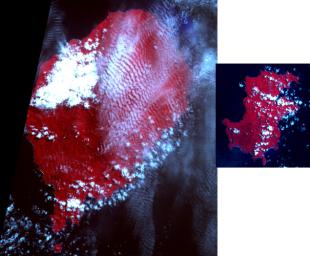The Democratic Republic of Sao Tome and Principe is an island country in the Gulf of Guinea, off the western equatorial coast of central Africa. It is the second smallest African sovereign state, and consists of two archipelagos around the two main islands, about 150 km apart. About 100 years ago, this twin-island nation was the biggest producer of chocolate in the world. Now several producers are seeking to revitalize the trade. The images were acquired May 25, 2018 (Sao Tome, left), and April 5, 2020 (Principe, right); cover areas of 42 by 49.5 km, and 18.3 by 20.1 km; and are located at 0.2 degrees north, 6.6 degrees east; and 1.6 degrees north, 7.4 degrees east.
With its 14 spectral bands from the visible to the thermal infrared wavelength region and its high spatial resolution of about 50 to 300 feet (15 to 90 meters), ASTER images Earth to map and monitor the changing surface of our planet. ASTER is one of five Earth-observing instruments launched Dec. 18, 1999, on Terra. The instrument was built by Japan's Ministry of Economy, Trade and Industry. A joint U.S./Japan science team is responsible for validation and calibration of the instrument and data products.
The broad spectral coverage and high spectral resolution of ASTER provides scientists in numerous disciplines with critical information for surface mapping and monitoring of dynamic conditions and temporal change. Example applications are monitoring glacial advances and retreats; monitoring potentially active volcanoes; identifying crop stress; determining cloud morphology and physical properties; wetlands evaluation; thermal pollution monitoring; coral reef degradation; surface temperature mapping of soils and geology; and measuring surface heat balance.
The U.S. science team is located at NASA's Jet Propulsion Laboratory in Pasadena, Calif. The Terra mission is part of NASA's Science Mission Directorate, Washington.
More information about ASTER is available at http://asterweb.jpl.nasa.gov/.

 Planetary Data System
Planetary Data System












